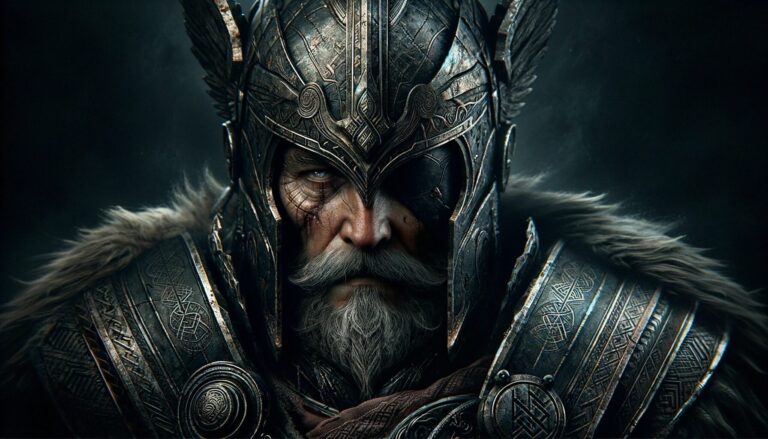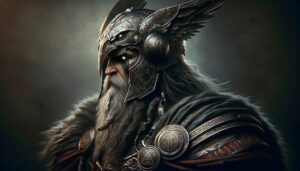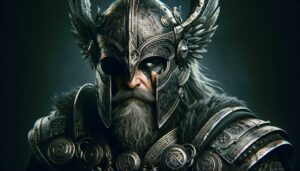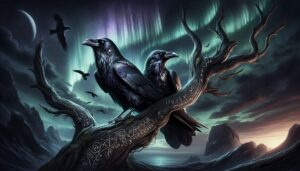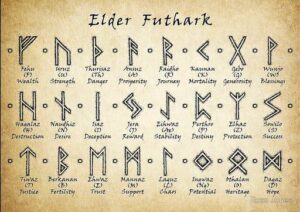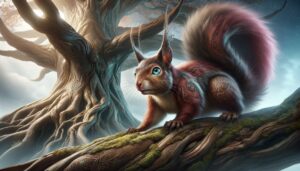Table of Contents
In the realm of Norse and Germanic mythology, there exists a figure of unparalleled significance, a deity whose multifaceted character embodies the very essence of the ancient North’s beliefs, values, and aspirations. Additionally, Odin, pronounced as “OH-din,” stands as a paramount figure, a god of exceptional complexity and influence. Moreover, his story, attributes, and symbolism resonate deeply within the annals of mythology, making him a captivating subject of exploration.
Origins and Family:
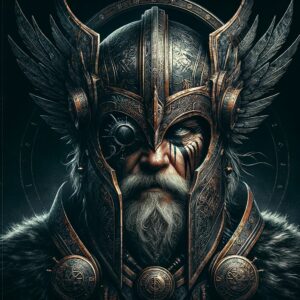
Odin’s origins are deeply rooted in Germanic and Norse mythology. Furthermore, he is the son of Bor and Bestla, he emerged from the primordial chaos that predated creation itself. Additionally, his lineage ties him to the Aesir, a pantheon of gods who would come to shape the cosmos. Odin’s parentage reflects his dual nature, a blending of the divine and elemental forces that characterize the Norse worldview.
Odin is married to Frigg, the queen of the Aesir, and together they have children, including Balder, Hod, and Hermod.
The reference to Odin emerging from the primordial chaos may not be a literal birth but rather a poetic way to emphasize his ancient and foundational role in the mythology. It symbolizes his existence before the structured world came into being, highlighting his primordial significance.
Symbolism and Symbolic Interpretations:
Odin’s character is layered with symbolism that transcends his role as a deity. Additionally, his one-eyed visage, a result of a sacrifice made for wisdom, symbolizes the price of knowledge, suggesting that true enlightenment often comes at great personal cost. Furthermore, this act of self-mutilation underscores Odin’s relentless pursuit of wisdom and the sacrifices he is willing to make to acquire it.
His cloak and hat, worn during his wanderings through the realms, signify his ability to move between worlds and his pursuit of hidden knowledge. Odin’s animal companions, the wolves Geri and Freki and the ravens Huginn and Muninn, serve as emissaries, embodying thought, memory, and the predatory instincts that guide him.
The Triple Horn of Odin, a prominent symbol associated with him, represents the interconnectedness of his roles as god of knowledge, poetry, and death. Moreover, the three drinking horns, intertwined, evoke the idea that these aspects of existence are intertwined and cannot be separated. Additionally, this symbol has enduring significance in modern Asatru faith, a revival of Norse pagan traditions.
Appearance
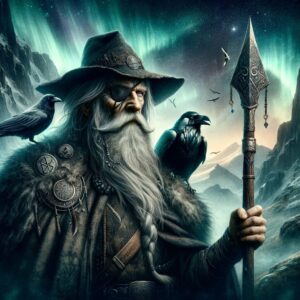
In the visual tapestry of mythology, artists often depict Odin as a regal figure with a long beard and a single eye, symbolizing his sacrifice at Mimir’s Well. His other eye remains closed, veiled in shadow, yet ever watchful. Moreover, he carries the formidable Gungnir, a spear of divine craftsmanship, symbolizing his authority and martial prowess.
Odin’s steed, Sleipnir, a magnificent eight-legged horse, conveys his dominion over the realms. Furthermore, with Sleipnir, he can traverse the cosmos, including the heavens and the underworld. Additionally, this exceptional horse, borne of a union between Loki and the giantess Angrboða, stands as a testament to the mingling of divine and chaotic forces.
Abilities
One of Odin’s most remarkable abilities is his insatiable thirst for knowledge. He relentlessly seeks wisdom through various means, such as his self-sacrifice at Yggdrasil, the world tree, and his visits to Mimir’s Well. This unquenchable desire for understanding underscores his role as the god of knowledge and poetry.
Odin’s influence extends beyond the intellectual realm. He possesses the power of seidr, a form of sorcery and divination, often associated with the feminine. This mastery of magic grants him insight into the threads of fate and the ability to shape destinies.
Cultural Impact and Thematic Exploration
The presence of Odin in Norse mythology profoundly shaped the culture, beliefs, and worldview of the ancient Germanic and Scandinavian peoples. Furthermore, his role as the chief god of the Aesir, the pantheon that includes Thor, Freyja, and Loki, cemented his status as a central figure in their religious practices.
The veneration of Odin among the Vikings and other Norse tribes left an indelible mark on their society. Moreover, he embodied their martial ethos, inspiring warriors to seek glory on the battlefield and to fearlessly face death, for Odin was the “father of the slain,” welcoming fallen warriors to Valhalla, his great hall of the afterlife.
The theme of sacrifice, inherent in Odin’s character, permeates Norse mythology. Whether it is his sacrifice of an eye for wisdom, his hanging from Yggdrasil to obtain the runes, or the human sacrifices made in his name, Odin’s story underscores the significance of offering something valuable in exchange for knowledge, power, or favor from the divine.
Myths and Stories
Odin’s myths and stories are as diverse as his roles within the pantheon. Among the most renowned are:
The Myth of Odin’s Missing Eye: In his quest for knowledge, Odin sacrifices an eye to Mimir, a shadowy being guarding the Well of Urd. This story serves as a poignant allegory for the pursuit of wisdom, demonstrating that enlightenment often requires personal sacrifice.
Odin’s Self-Sacrifice: Odin’s hanging on Yggdrasil, his self-inflicted wound with a spear, and his nine-day ordeal without food or water are iconic elements of his mythology. These acts of self-sacrifice lead to his acquisition of the runes, the ancient alphabet imbued with cosmic secrets.
Odin Tricks a Giant: Odin’s insatiable curiosity and competitive nature lead him to challenge a giant in a contest of knowledge, with the prize being the loser’s head. His cunning question, something only he would know, secures his victory but raises questions about the ethics of such a victory.
Relationships
In Norse mythology, Odin’s alliances, friendships, and enmities are central to the complex web of relationships within the pantheon. Here’s a breakdown of some key connections:
Alliances and Friendships
The Aesir: Odin is the chief of the Aesir, a powerful group of gods that includes Thor, Frigg, Tyr, and many others. He is their leader, and they are bound by a sense of camaraderie and shared purpose, particularly in the face of the impending Ragnarök, the end of the world.
Frigg: Odin’s wife, Frigg, is a significant ally and confidante. She is the queen of the Aesir and shares in Odin’s rule over the cosmos. Their relationship underscores their shared responsibilities and roles as rulers of the divine realm.
Freyja: While Freyja primarily belongs to the Vanir tribe of gods, she is often associated with the Aesir due to her close ties with them. Odin may have a connection with Freyja through her role in magic and divination.
Mimir: Odin seeks knowledge from Mimir, the guardian of the Well of Urd, and willingly sacrifices an eye for the wisdom Mimir possesses. This exchange forms a unique alliance between the two, as Mimir becomes a source of profound knowledge for Odin.
Enmities and Conflicts
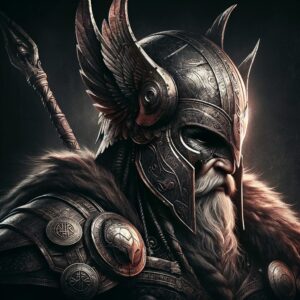
The Giants: Giants, often depicted as chaotic and antagonistic beings in Norse mythology, are frequent adversaries of the Aesir. Odin and the Aesir engage in conflicts with giants, symbolizing the eternal struggle between order and chaos.
Loki: While Loki is a member of the Aesir, he is also a source of conflict and tension within the pantheon. His mischievous nature often leads to discord and challenges Odin’s authority. Loki’s role as a trickster figure makes him both a friend and a foe.
Ragnarök: Odin’s ultimate enemy is the prophecy of Ragnarök, the final battle that will bring about the destruction of the world and the death of many gods, including Odin himself. While he prepares for this cataclysmic event, it represents an existential enmity that cannot be avoided.
Other Deities: Odin’s complex and multifaceted character sometimes leads to strained relationships with other deities in the Norse pantheon. His pursuit of knowledge and his willingness to make sacrifices may put him at odds with those who question his methods.
Odin’s Legacy and Endurance
Odin’s legacy endures not only through mythology but also in modern culture. His influence can be seen in contemporary literature, music, and even popular culture. Writers, artists, and scholars continue to draw inspiration from his multifaceted character and the rich tapestry of Norse mythology.
In conclusion, Odin, the god of healing, death, and knowledge, emerges as a god of remarkable complexity, embodying the paradoxes of life and existence. His symbolism, appearance, and abilities all intertwine to create a deity whose influence reaches far beyond the realm of mythology. His stories serve as a reflection of humanity’s eternal quest for wisdom, the price paid for enlightenment, and the enduring legacy of a god whose name continues to resonate across the ages. Odin, the Allfather, the Wanderer, and the One-Eyed God, stands as a testament to the enduring power of myth and the profound impact of ancient belief systems on the human psyche.
FAQ
Who is Odin?
Odin is a major deity in Norse and Germanic mythology, often regarded as the chief god. He represents various aspects, including knowledge, poetry, death, and battle.
What is Odin's symbol?
Odin's symbol is the Triple Horn, which consists of three interlocked drinking horns. It represents his roles as a god of knowledge, poetry, and death.
Why does Odin have one eye?
Odin sacrificed one of his eyes at Mimir's Well in exchange for wisdom and knowledge, emphasizing his dedication to acquiring cosmic insights.
Who are Odin's children?
Odin had several children, including Balder, Hod, Hermod, Thor (with goddess Jord), and Vider (with giantess Grid).
Who is Odin's wife?
Odin's wife is Frigg, who is also a prominent goddess in Norse mythology and the mother of some of his children.
What is Odin's horse called?
Odin's horse is named Sleipnir, a remarkable eight-legged steed capable of traversing various realms.
What are Odin's main attributes?
Odin is known for his wisdom, knowledge, mastery of magic (seidr), and his association with poetry, death, and the runic alphabet.
How does Odin prepare for Ragnarök?
Odin prepares for Ragnarök, the end of the world, by gathering fallen warriors in Valhalla and seeking knowledge to prepare for the impending battle.
What is the significance of Odin's ravens and wolves?
Odin's ravens, Huginn (thought) and Muninn (memory), bring him information from the world, while his wolves, Geri and Freki, represent his warrior aspect.
How did Odin become the chief god?
Odin's ascent to the position of chief god is linked to a transition of power in the Norse pantheon, possibly due to his roles similar to those of Zeus and the Celtic god Lugh.
